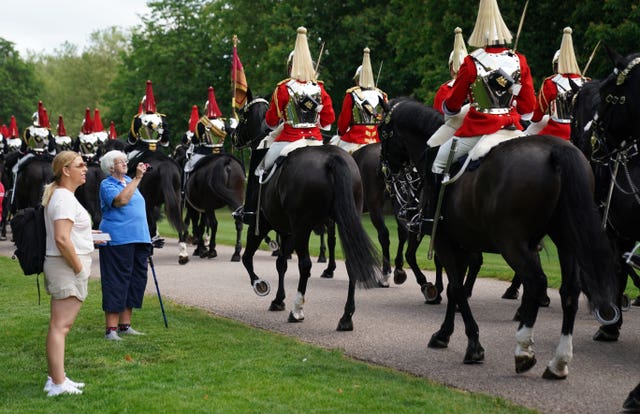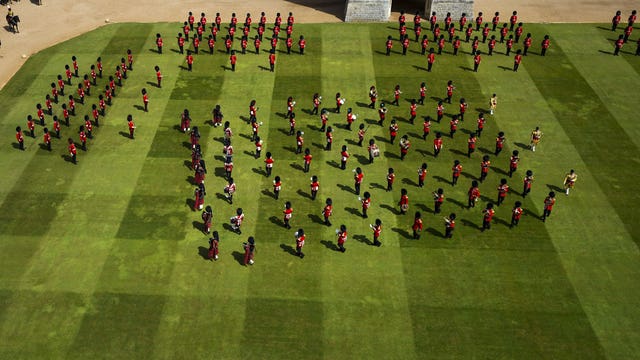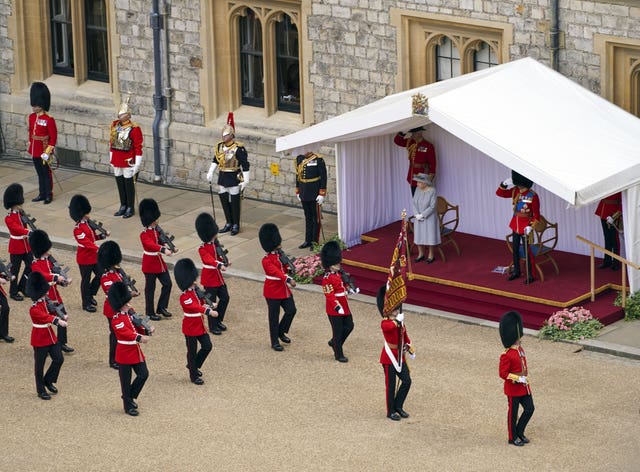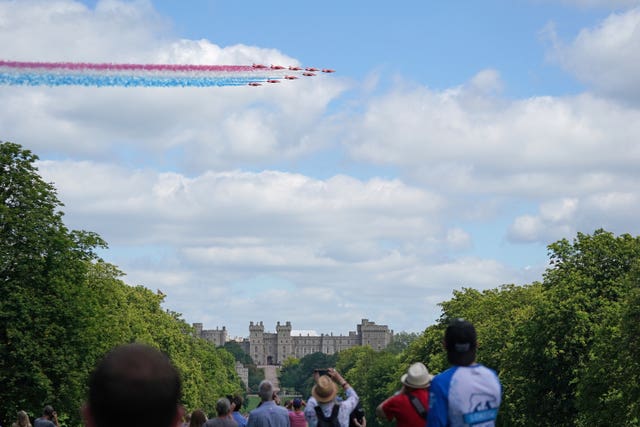Military parade marks Queen’s official birthday
The traditional Trooping the Colour ceremony in London was cancelled due to the pandemic.
The Queen has received her official birthday gift from the nation’s armed forces – a ceremony of pomp and pageantry in her honour.
Windsor Castle was the setting for the spectacle dubbed a mini Trooping the Colour, featuring soldiers who have supported communities and the NHS during the pandemic or served overseas on military operations.
From her dais, the Queen watched the ceremony unfold with Guardsmen in their scarlet tunics and bearskins and the Household Cavalry Mounted Regiment in their breast plates and plumed helmets.
The birthday parade is a gift from the Household Division – the Army’s most prestigious regiments – which has a close affinity with the monarch and is keen to show its loyalty to the Crown.
The traditional Trooping the Colour ceremony, which is normally staged in London and features hundreds of servicemen and women and thousands of spectators, was ruled out for the second successive year because of the threat of coronavirus.
Lieutenant Colonel Guy Stone, who planned the Queen’s official birthday celebrations in Windsor Castle’s quadrangle, said he wanted to create a “memorable and uplifting day” for the monarch.
After a year which has seen the Queen mourn the loss of her beloved husband the Duke of Edinburgh and experience family upheavals following accusations made by the Duke and Duchess of Sussex, the ceremony was a positive event.
Lt Col Stone, Brigade Major Household Division, who was also in overall charge of the military arrangements for Philip’s funeral, said: “It is the highlight of the year and a poignant way for the Household Division to thank Her Majesty for all that she does for the nation, particularly through this challenging time.”

Guardsman stand in formation at Windsor Castle

Members of the Massed Band of the Household Division during the ceremony
The Queen’s cousin the Duke of Kent joined her on the dais in his role as Colonel of the Scots Guards.
The Colour or ceremonial flag being trooped past the soldiers was the Colour of the 2nd Battalion Scots Guards with the regiment’s F Company given the task of performing the honour.
On parade in front of the Queen in bright summer sunshine was an array of socially distanced Guardsmen, mounted Troopers and the King’s Troop Royal Horse Artillery.
They were joined by a massed band of the Household Division – musicians from all of the five Foot Guards Bands and the 1st Battalion Scots Guards Pipes and Drums.
The servicemen and women on parade numbered almost 275, with 70 horses, compared with the 85 soldiers who took part in the ceremony last summer.

Members of the Household Cavalry make their way down the Long Walk towards Windsor Castle ahead of the ceremony

The Massed Band of the Household Division perform at Windsor Castle
A rare sight on the parade ground were two officers who were father and son.
Colonel Jeremy Bagshaw, Chief of Staff at Army Headquarters London District, was stood close to the Queen’s dais while his 18-year-old son, 2nd Lieutenant Henry Bagshaw, Coldstream Guards, was formed up in front of the monarch.
A small handful of seated guests lined part of the quadrangle – a change from last year when only the military were present.
The playing of the national anthem as a royal salute was given by soldiers signalled the start of the ceremony and the Massed Bands marched past first in slow then quick time.
They performed the feathering technique, named as it resembles the Prince of Wales’s feathers when seen from above, and used to allow the marching musicians to turn 180 degrees and maintain individual distances.
A lone drummer played the Drummer’s Call that signalled the group of soldiers and officers known as the Escort for the Colour to get into position.
Lieutenant Hugh Dingwall was given the honour of carrying the Colour which has deep symbolic significance and it was trooped through the ranks.
During the birthday parade, Guardsmen from three regiments – Scots, Grenadier and Coldstream Guards – marched past the Queen who stood to acknowledge them.

The Queen during the ceremony at Windsor Castle

The Queen looks on during the ceremony
A few minutes later the gravel path around the castle’s quadrangle was kicked up by the hooves of dozens of horses ridden by the Captain’s Escort – two divisions from the Household Cavalry Mounted Regiment – and the King’s Troop Royal Horse Artillery who paraded past the monarch.
The Queen was also treated to the sight of a Red Arrows flypast as the ceremony drew to a close and nine jets roared above the town of Windsor trailing red, white and blue smoke.
She was seen pointing up at the aerial display as the planes spend overhead in a few seconds.

The Red Arrows fly over Windsor Castle to mark the Queen’s official birthday
The assembled military units marched off the quadrangle as music was played and the Queen, who wore a matching coat and hat by Angela Kelly with the aquamarine bar brooch, waited until the sound of the pipes were fading before she left her seat.
Later the King’s Troop fired a 41-gun royal salute from Castle’s East Lawn, using three of their First World War era guns, to mark the Queen’s official birthday.
The Press Association
Latest posts by The Press Association (see all)
- BBC to air two-part Call The Midwife Christmas special - December 23, 2024
- 6 mind sports to exercise your brain and keep you sharp - December 20, 2024
- Quiz: What classic Christmas food or drink are you? - December 20, 2024
- Leftover turkey and watercress pie - December 20, 2024
- Catherine and William choose family shot for Christmas card photograph - December 19, 2024




















